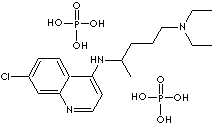PRODUCT IDENTIFICATION

H.S. CODE
TOXICITY
SMILES
CLASSIFICATION
Antibiotic, Analgesics, Non-Narcotic, Anthelmintic, Anti-Infective, Anti-amebic, Anti-inflammatory agent non-steroidal; Antimalarial; Antinematodal, Antiparasitic, Antiprotozoal, Antirheumatic, Filaricide, Quinoline
EXTRA NOTES
Standard anti-malarial drug. Substrate for MRP in multidrug resistant cell line and inhibits photoaffinity labeling of MRP by quinoline-based photoactive drug IAAQ (N-[4-[1-hydroxy-2-(dibutylamino)ethyl]quinolin-8-yl]-4-azidosalicylamide).
PHYSICAL AND CHEMICAL PROPERTIES
REFRACTIVE INDEX
Stable under ordinary conditions
EXTERNAL LINKS & GENERAL DESCRIPTION
Drug Information Portal (U.S. National Library of Medicine) - Chloroquine
http://www.hopkinslupus.org/
Hydroxychloroquine (Plaquenil), chloroquine (Aralen), and quinacrine
(Atabrine) are medications that were originally used to prevent or treat
malaria. However, during World War II it was also found that these medications
were effective in treating the symptoms of lupus. Specifically, anti-malarial
medications have shown to improve muscle and joint pain, skin rashes,
pericarditis (inflammation of the lining of the heart), pleuritis (inflammation
of the lining of the lung), and other lupus symptoms such as fatigue and fever.
These medications may also prevent lupus from spreading to certain organs, such
as the kidney and central nervous system (your brain and spinal cord) and may
help to reduce flares by as much as 50%. Plaquenil and other anti-malarials are
the key to controlling lupus long term, and some lupus patients may be on
Plaquenil for the rest of their lives. For this reason, you can think of
anti-malarials as a sort of “lupus life insurance.” Studies have shown lupus patients on anti-malarials actually live longer than
those who are not, and these medications are usually prescribed when someone is
first diagnosed with the disease. Anti-malarials are particularly useful in
treating discoid lupus, subacute cutaneous lupus, and mouth sores associated
with lupus; they are also effective in treating rheumatoid arthritis and
Sjogren’s syndrome. However, anti-malarials are not a sufficient treatment for
more severe lupus symptoms such as kidney disease and nervous system or blood
vessel involvement. When lupus spreads to these organs, immunosuppressive
medications are usually added to help minimize irreversible injury.
Local:
Chloroquine is used as an drug to treat and prevent mainly malaria. Malaria is
one of leading re-emerging infectious disease due to murative malarial parasite
developed resistance to chloroquine. Sulfadoxine-pyrimethamine is an alternative
can be used in the treatment of the disease resistant to chloroquine, but
resistance to sulfadoxine-pyrimethamine has been reported also in some areas.
Artemisinin is an alternative used in areas where the disease has become highly
resistant to sulfadoxine-pyrimethamine. Chloroquine-resistant
falciparum malaria should be treated with quinine sulfate, sulfonamide,
doxycycline or with clindamycin. Other effective synthetic anti-malaria drugs are quinacrine, chloroquine, and primaquine.
Vaccines against malaria are still
experimental.
Chloroquine Molecules
|
Product |
CAS RN |
|
Chloroquine phosphate |
50-63-5 |
| Chloroquine | 54-05-7 |
| Chloroquine 4-acetaminosalicylate | 58-77-5 |
| Chlorquinaldol | 72-80-0 |
| 3-Methylchloroquine | 85-10-9 |
| 3-Carboxy-4-hydroxy-7-chloroquinoline | 86-47-5 |
| 4,7-Dichloroquinoline | 86-98-6 |
| 7-Chloro-4-hydroxyquinoline | 86-99-7 |
| 6-Chloroquinaldine | 92-46-6 |
| N,2,6-Trichloro-4-benzoquinone imine | 101-38-2 |
| Hydroxychloroquine | 118-42-3 |
| Chloranil | 118-75-2 |
| Clioquinol | 130-26-7 |
| Cloxyquin | 130-16-5 |
| Chloroquine sulfate | 132-73-0 |
| 8-Chloroquinoline | 611-33-6 |
| 4-Chloroquinoline | 611-35-8 |
| 3-Chloroquinoline | 612-59-9 |
| 6-Chloroquinoline | 612-57-7 |
| 2-Chloroquinoline | 612-62-4 |
| 2-Chloro-1,4-hydroxyquinone | 615-67-8 |
| 5-Chloroquinoline | 635-27-8 |
| 2-Chloro-1,4-benzoquinone | 695-99-8 |
| 2,6-Dichlorobenzoquinone | 697-91-6 |
| Hydroxychloroquine sulfate | 747-36-4 |
| Chloroxine | 773-76-2 |
| 7-Chloroquinolin-8-ol | 876-86-8 |
| Chloroquinine phosphate | 1446-17-9 |
| 2-Chloroquinoxaline | 1448-87-9 |
| Desethylchloroquine | 1476-52-4 |
| 2,3-Dichloroquinoxaline-6-carbonylchloride | 1919-43-3 |
| 2,3-Dichloroquinoxaline | 2213-63-0 |
| 2-Chloroquinoline-4-carbonyl chloride | 2388-32-1 |
| 4,11-Dichloroquinacridonequinone | 2389-75-5 |
| 2,9-Dichloroquino(2,3-b)acridine-6,7,13,14(5H,12H)-tetrone | 2490-60-0 |
| 2,3,6-Trichloroquinoxaline | 2958-87-4 |
| Chlorquinox | 3495-42-9 |
| Chloroquine hydrochloride | 3545-67-3 |
| Glafenine | 3820-67-5 |
| Chloroquine mustard | 4213-44-9 |
| N,N-Dideethylchloroquine | 4298-14-0 |
| Cletoquine | 4298-15-1 |
| Chloroquine-ethyl phenyl mustard | 4465-92-3 |
| 4-Chloroquinazoline | 5190-68-1 |
| 4-(3',5'-Bis(pyrrolidinomethyl)-4-hydroxyanilino)-7-chloroquinoline | 5201-88-7 |
| 6-Chloroquinoxaline | 5448-43-1 |
| 6-Chloro-8-aminoquinoline | 5470-75-7 |
| 2-Chloromethyl-4-phenyl-6-chloroquinazoline-3-oxide | 5958-24-7 |
| 2-Chloroquinazoline | 6141-13-5 |
| 4-(2-Methyl-1-pyrrolidyl)-7-chloroquinoline | 6281-58-9 |
| 6,7-Dichloroquinoline-5,8-dione | 6541-19-1 |
| 6,7-Dichloroquinoxaline-2,3-dione | 6639-79-8 |
| Cloquinate | 7270-12-4 |
| 8-Quinolinol, 7-bromo-5-chloro- | 7640-33-7 |
|
Collagenan |
8055-81-0 |
| Dichlorquinazine | 10547-40-7 |
| 4,7-Dichloroquinolinium tribromide | 12365-92-3 |
| Chloroquinoline | 15847-17-3 |
| Chloroquine diorotate | 16301-30-7 |
| 2,4,6-Triamino-5-chloroquinazoline | 17511-20-5 |
| Methyl-8-(5,7-dichloroquinolyl)carbonic acid ester | 18119-52-3 |
| 6-Amino-7-chloro-5,8-dioxoquinoline | 18892-39-2 |
| 4,8-Dichloroquinoline | 21617-12-9 |
| 5-Chloroquinolin-8-ol hydrochloride | 25395-13-5 |
| 3-Phenyl-4-hydroxy-7-chloroquinolin-2(1H)-one | 28563-19-1 |
| N-Methyl-6-chloroquinolinium iodide | 32596-83-1 |
| 3-Chloroquinuclidine hydrochloride | 33601-77-3 |
| Halacrinate | 34462-96-9 |
| 1-Phenacyloxime-4,5-dichloroquinolinium chloride hydrate | 36226-69-4 |
| Chloroquine diascorbate | 38305-48-5 |
| 2-(7-Chloroquinolin-4-yl)anthranilic acid hidrochloride | 53560-21-7 |
| Tripiperaquine | 53658-96-1 |
| 2-(2-Chlorostyryl)-4-(delta-diethylamino-alpha-methylbutylamino)-7-chloroquinazoline | 57942-32-2 |
| (+)-Chloroquine | 58175-86-3 |
| (-)-Chloroquine | 58175-87-4 |
| 7-Chloro-4-(3-octylaminopropyl)aminoquinoline 1-oxide | 63680-59-1 |
| Ethyl chloroquine mustard | 63717-15-7 |
| L-Chloroquine | 67459-54-5 |
| 2,6-Dianilino-6-chloroquinoxaline | 68413-85-4 |
| 2-(2-(5-Nitrofuryl)vinyl)-4-(delta-diethylamino-alpha-methylbutylamino)-7-chloroquinazoline | 69258-64-6 |
| D-Chloroquine | 69698-55-1 |
| 2,3-Bis(allylamino)-6-chloroquinoxaline | 71205-46-4 |
| 7-Chloroquinolin-4-ol hydrochloride | 71799-41-2 |
| 2-Amino-3,4-dichloroquinoline | 73987-35-6 |
| Quizalofop | 76578-12-6 |
|
Presocyl |
78456-99-2 |
| Tris(5,7-dichloroquinolin-8-olato-N1,O8)aluminium | 78970-14-6 |
|
Contramibial |
83097-13-6 |
| Quinclorac | 84087-01-4 |
| N-(4-((7-Chloroquinolin-4-yl)amino)pentyl)-N-ethylacetamide | 91828-61-4 |
| 7-Bromo-5-chloroquinolin-ol | 94275-80-6 |
| Chlorsulfaquinoxaline | 97919-22-7 |
| 1-Dimethylaminopropyl-3-methyl-6-chloroquinoxaline-2(1H)-one | 102582-79-6 |
| Propaquizafop | 111479-05-1 |
| 3-Chloroquinoline-8-carboxylic acid | 125300-42-7 |
| 5,10,15,20-Tetraphenyl-1-3-(4-(4-aminobutyl)-7-chloroquinoline)propioamidoporphine | 130170-25-1 |
| 4-((Carboxymethyl)amino)-5,7-dichloroquinoline-2-carboxylic acid | 130613-18-2 |
| 4-((Carboxymethyl)oxy)-5,7-dichloroquinoline-2-carboxylic acid | 130613-17-1 |
| 5,7-Dichlorokynurenic acid | 131123-76-7 |
| N1,N2-Bis(7-chloroquinolin-4-yl)cyclohexane-1,2-diamine | 140926-77-8 |
| Meclinertant | 146362-70-1 |
| 5-(2-(1-(3-(2-(7-Chloroquinolin-2-yl)ethenyl)benzyl)indol-7-yl)ethyl)-1H-tetrazole | 146554-87-2 |
| (N1-(7-Chloroquinolin-4-yl)-3-(N3,N3-diethylamino)propylamine) dihydrochloride trihydrate | 169815-40-1 |
APPEARANCE
ASSAY
96.0 % min
WATER
3.0% max